General function of tires for all types of vehicles
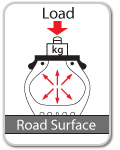
1. Weight-bearing
Air pressure and tire construction are important factors to carry and sustain the weight of vehicles.
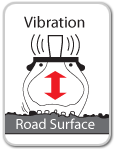
2. Absorb shocks
Air pressure and tire construction reduces initial road vibrations and shocks before being muted again by the suspension.
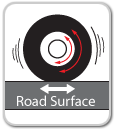
3. Delivering power from the engine
Tires serve to deliver power from the engine to move the vehicle and also provides traction and braking performance.

4. Translating steering wheel movement
Tires are very important in controlling the direction of the vehicle, which will determine the maneuvering capability and stability in driving.
Understand tire size
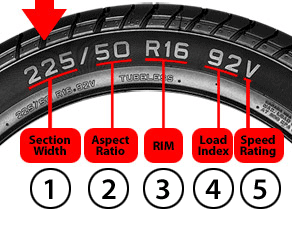
Here are the meanings of these codes:
1. Tire width (in mm)
2. A tire’s aspect ratio is the dimensional relationship of the tire’s section height to section width, expressed as a percentage.
3. Diameter of wheel (in inches)
4. Load Index
5. Speed Index
UTQG (Uniform Tire Quality Grades) Rating
The UTQG (Uniform Tire Quality Grades) rating is a labeling requirement by the U.S Department of Transportation for all tire manufacturers. The label of UTQG represents a tire’s Treadwear, Traction and Temperature resistance. Traction and temperature resistance ratings are specific performance levels, while treadwear ratings are assigned by manufacturers following tests conducted and are reliable when comparing tires of the same brand.
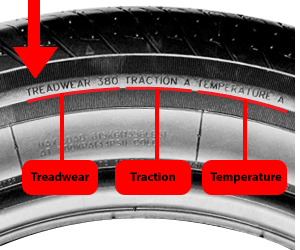
The UTQG rating comprises of 3 components.
Treadwear
The treadwear grade indicates the wear rate of a tire and is a comparative rating based on test conducted by tire manufacturers. The grades are not an indication of actual mileage, but can be used as a relative comparison. For example, a grading of 400 should last twice as long as a tire graded 200, given similar driving conditions in the same brand.
Traction
Traction rating is an indication of a tire’s ability to stop on wet pavement. The braking distance is indicated by ratings of “AA” (highest braking ability), “A”, “B” and “C”. Traction rating only indicates straight line wet braking and does not indicate wet cornering abilities of the tire.
Temperature
Temperature resistance rating indicates the tire’s ability to withstand heat. It is graded according to a properly inflated and not overloaded tire. It is graded from “C”, being the lowest, to “B” and “A” ratings.
Understand Load Index and Speed Rating
The Speed index is an assigned letter ranging from J to Z that corresponds to the reference maximum speed at the associated load index. Refer to the load index and speed rating tables below.
These two elements put together are called the service description and are mutually dependent. The table below gives the load index and the speed symbol with their corresponding value.
Load Index (Symbol and maximum load in Lbs & Kg)
| LI | Lbs | Kgs | LI | Lbs | Kgs | LI | Lbs | Kg | LI | Lbs | Kg |
|
71 72 73 74 75 76 77 78 79 80 |
761 783 805 827 853 882 908 937 963 992 |
345 355 365 375 387 400 412 425 437 450 |
81 82 83 84 85 86 87 88 89 90 |
1019 1047 1074 1102 1135 1168 1201 1235 1279 1323 |
462 475 487 500 515 530 545 560 580 600 |
91 92 93 94 95 96 97 98 99 100 |
1356 1389 1433 1477 1521 1565 1609 1653 1709 1764 |
615 630 650 670 690 710 730 750 775 800 |
101 102 103 104 105 106 107 108 109 110 |
1819 1874 1929 1984 2039 2094 2149 2205 2271 2337 |
825 850 875 900 925 950 975 1000 1030 1060 |
Speed Rating (symbol and maximum speed in MpH & KmH)
| J | K | L | M | N | P | Q | R | S | T | H | V | W | Y | |
| MpH |
62
|
68
|
75
|
81
|
87
|
93
|
100
|
106
|
113
|
118
|
130
|
150
|
168
|
188
|
| KmH |
100
|
110
|
120
|
130
|
140
|
150
|
160
|
170
|
180
|
190
|
210
|
240
|
270
|
300
|
Note: A “ZR” may appear for tires having a maximum speed capability above 240km/h (150 mph)
Guide on when to replace your tyres

Every tire has a Tread Wear Indicator (TWI), which form a triangle  located on the sidewall. TWI is an indicator of tire wear and is also a benchmark to you to check if your tire is worn out. Tires should be changed immediately when the tire tread has surpassed the indicators.
located on the sidewall. TWI is an indicator of tire wear and is also a benchmark to you to check if your tire is worn out. Tires should be changed immediately when the tire tread has surpassed the indicators.

Worn out tires compromises handling and braking distance tremendously.
 Do keep a lookout for physical signs stated below, even if the tires have not worn out yet
Do keep a lookout for physical signs stated below, even if the tires have not worn out yet
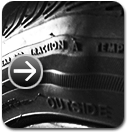
Bulges on tires
We recommend you to replace the tires immediately, due to high potential of tires bursting

Patches
A sign of potential air leak
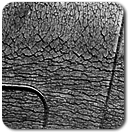
Cracks
Normally on the tire’s sidewall
Consult your nearest tire dealer if there are any signs of physical damage or deformity of your tires.
Few tips to maximize your tire performance and durability
- Check your tires air pressure at least once a month. Adjust the air pressure according to the manufacturer’s instruction manual
- Tire balancing and wheel alignment will increase tire mileage and maintains the performance of the tires
- Use only tire cleaners and water to clean your tires
Air pressure
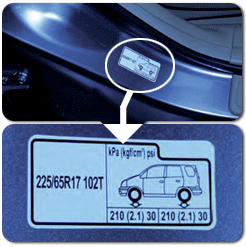
Low air pressure can cause damage to the sidewall, thus decreasing the load carrying capacity, and also consume more fuel. Hence the tire pressure should be checked regularly, at least once every month.
 Note:
Note:
Allow the tires to cool down after driving before checking the air pressure in order to obtain a more accurate reading.

Improper air pressure leads to irregular wear of the tires.
Wear and tear in the middle of the tire is caused by excessive air pressure. On the other hand, low air pressure results in uneven wear on both sides of the tire shoulder.
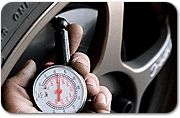
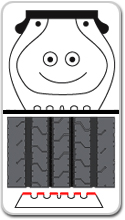
Correct air pressure
results in regular wear and tear of the tire, thus providing a longer tire life
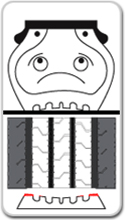
Low air pressure
results in wear and tear on both sides of the tire shoulder, creating uneven wear of the tire
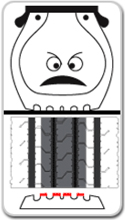
Excessive air pressure
results in wear and tear on the middle of the tire, which results in uneven wear of the tire
Rotate your tyre regularly to improve tire life
Regular tire rotation helps to prolong the tire’s life and maintains optimum performance and mileage of the tires. Tires not rotated on regular basis will result in uneven wear and will also compromise the performance of the tires over time.
 Rotation is required when the tire mileage reaches between 8000-10,000 km.
Rotation is required when the tire mileage reaches between 8000-10,000 km.
There are 2 different ways of tire rotation, the 4-Tire rotation and 5-Tire rotation.
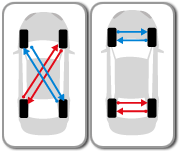
Diagonal / Horizontal

Vertical
4-Tire rotation
Can be done by diagonal, horizontal or vertical rotation
For diagonal rotation;
it is done by swapping the front left tire to right rear and front right tire with the rear left.
For horizontal rotation,
it is done by exchanging the front right wheel with the left front wheel. Likewise for the rear wheels, rear right tire will be exchanged with the left rear tire. This method is normally used for non-directional tires.
For vertical rotation,
it is done by swapping the front right tire with the back right tire, and the front left tire with the back left tire. This method is normally used for directional tread pattern tires.
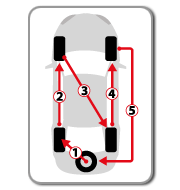
5-Tires rotation (with spare tire)
5 tire rotation relatively similar to the 4 tire diagonal, except that the spare tire will also be rotated. The spare tire is to be mounted on the left rear, left rear tire moved to the front left. The left front tire will be moved to right back and right back to be moved to the front right. Lastly, the right front tire will be used as the spare tire. This method of rotation is normally used for 4-wheel and all-wheel drive vehicles.
Note: Do not use the 5-Tire rotation method if the spare tire is of a different brand/model to the rest of the tires.
Tire tread patterns
There any many brands and patterns of tires available today. So how do you know that you are choosing the tires suitable for your driving needs?
Generally, tire patterns can be differentiated into 3 categories. The Directional pattern, also known as Unidirectional, the Non-Directional pattern, also known as symmetric, and the Asymmetric pattern.
All three categories of tire patterns have different characteristics to provide for different needs of drivers.
Directional/
Unidirectional

Directional pattern tires have lateral grooves on both side of the tire which points in the same direction. It is usually in a “V-shaped” pattern.
Features:
- Increase water dispersion to provide good handling in both wet and dry road conditions
- Better steering and braking capabilities
- Usually available in bigger sizes (15″ and above) and high speed index
Suitable for:
Drivers who want to have high speed performance level of the tire.
Non-directional/
Symmetric
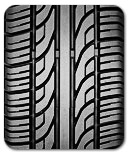
Non-directional pattern tires have tread pattern that usually has a continuous rib design or blocks which has the same features on both inside and outside tread face of the tire. It is normally in a “wave-like” pattern,
Features:
- Comfort, low noise design oriented tires
- Lateral grooves to provide water dispersion
Suitable for:
Drivers who want to have a comfortable and quiet drive.
Asymmetric
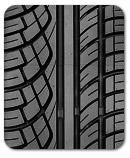
Asymmetric pattern tires have unique patterns differing on both sides of the tire tread. The outer tread area of the tire usually has larger grooves to disperse water to increase wet handling, while the inside tread area usually has smaller grooves to increase contact area with the road.
Features:
- Good handling capabilities on wet and dry roads
- Good high speed cornering capabilities
Suitable for:
Drivers who want tires with high performance capabilities.
Tire Glossary Terms
Below is a list of common tire terms you will often see in our industry and throughout our website.
4WD
A drivetrain that employs two differentials and a transfer case to provide power to all four wheels of a vehicle.
All-Season Tires
Tires designed to provide good traction in winter snow and slush without wearing too quickly on dry roads.
Aspect Ratio
Determined by the unloaded sidewall height of the tire divided by its overall width. A lower aspect ratio implies a shorter, wider tire.
AWD
All-wheel drive. A drivetrain that employs a front, rear and center differential to provide power to all four wheels of a vehicle.
Lockup
The juncture at which a tire starts to skid during braking.
Plus Size Wheels
Wheel and tire packages that are larger in diameter than those included in a vehicles standard equipment. Also known as “up-sized wheels.”
Spare Tire
A fifth wheel and tire that is stored on or in a vehicle for use when one of the four tires in use becomes disabled.
Track
The distance from the center plane of one wheel to the center plane of its opposing wheel.
Tread-Wear Index
A tire rating that consists of a number followed by two letters (i.e. 300AB). The number indicates the useful life of the tire, the first letter indicates its traction in wet conditions (A being the best), and the second letter indicates its resistance to heat buildup.
Wheel Width
The distance of a wheel from bead to bead.
